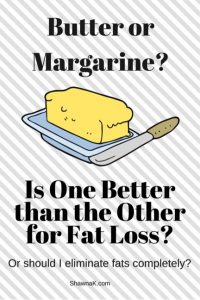Margarine is a non-dairy product created as a substitute for butter. While originally made from animal fat in the 1800s, today the primary ingredients include vegetable oil, water, salt, emulsifiers, and some also include milk.
Butter and margarine spreads may look and taste similar, but they’re not quite the same. Butter is made from fresh or fermented cream or milk. The process of churning the cream creates a solid. Margarine is made from vegetable oil or plant oils that have been extracted chemically and refined.
Fun fact: Margarine was invented in France by Hippolyte Mège-Mouriès in 1869, during the Franco-Prussian wars.  He invented it in response to a competitive challenge from the French government under Napoleon III, who was looking for a cheap and stable substitute for butter, and offered a big prize to anyone who could pull it off.
He invented it in response to a competitive challenge from the French government under Napoleon III, who was looking for a cheap and stable substitute for butter, and offered a big prize to anyone who could pull it off.
Vegetable-oil-based margarines surged in popularity as doctors began to understand the dangers of saturated fat. But the butter-versus-margarine debate is a slippery subject. Some margarines have unhealthy trans fats, while others have confusing health claims.
Butter has a firmer consistency than margarine and contains more saturated fat. The most important difference is that butter contains saturated fat and many margarines contain trans fats.
*Trans fat raises LDL (bad) cholesterol significantly while lowering HDL (good) cholesterol.
For baking and cooking: Margarine is not recommended for most baking since it has as little as 35% fat — the rest is mostly water. Only use margarine in a recipe that specifies it. If you used margarine in a cookie recipe that called for butter, you’d end up with cookies that spread out too thin and end up burned.
From the standpoint of heart disease, butter remains on the list of foods to use sparingly mostly because it is high in saturated fat. Margarines, though, aren’t so easy to classify. The older stick margarines turned out to be clearly worse for you than butter. Some of the newer margarines that are low in saturated fat, high in unsaturated fat, and free of trans fats are fine as long as you don’t use too much (they are still rich in calories).
You can quickly compare the health value of spreads (including butter and margarine) simply by looking at the nutrition labels on these products. The FDA now requires nutrition labels to include information about both saturated fats and trans fats. Your goal is to limit intake of saturated fats and to avoid trans fats altogether.
Healthier alternatives to butter or margarine include olive oil and other vegetable oil–based spreads, which contain beneficial mono- and polyunsaturated fats.
Regardless of whether you opt for margarine or butter, both are pure fat, and the rule of thumb is to eat no more than 20-30 per cent of calories from fat – this works out to around 50-75 grams of fat per day. However, of those fats allowed, less than seven per cent of total calories should be saturated fats.
Unless of course you’re following a ketogenic diet in which case your fat intake is 70-80%…
This is a diet that typically reduces carbohydrate intake to less than 20g daily (or 5-10% of caloric intake). The body is forced to burn ‘ketones’ for energy.
While this will work for fat loss, it can be difficult to maintain a lifestyle without eating carbohydrates long term.
Phew! That was a lot of info!
If you’d like to work with me and my team more closely to dial in your nutrition, pop me an email: shawna.kaminski@gmail.com
Make sure to find me, Coach Perri and a group of lovely supportive, like-minded women here on Facebook: https://www.facebook.com/groups/Healthysecrets/




